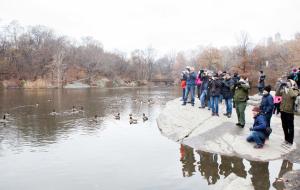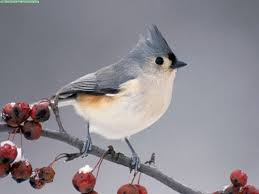With Winter Solstice just past and the year end approaching (with head-scratching mild weather persisting here in the east), there are plenty of reasons to get outside in Maryland this month. For inspiration, we once again turn to Bryan MacKay’s A Year across Maryland, his week-by-week guide to enjoying the natural world in JHUP’s home state.
Fourth Week of December: Saw-whet Owls
Winter brings to Maryland North America’s smallest and perhaps most appealing owl, the northern saw-whet. Just eight inches tall, with a large head and arresting yellow eyes, saw-whets are susceptible to predation by larger owls and other birds of prey because of their diminutive size. Hence, they choose densely vegetated habitats with a complex understory, where larger birds might have difficulty maneuvering. In Maryland, saw-whets overwinter on the Piedmont and the Eastern Shore and have been studied in depth on Assateague Island. Each year, one or two pairs may nest in extreme western Maryland.
 Saw-whet owls are common in North America, breeding in summer in boreal and northern hardwood forests across the northern tier of the United States and southern Canada. Many, but not all, migrate south with colder weather. The saw-whet owl population may be irruptive; that is, in years when their prey (primarily deer mice) are abundant, they will have significantly larger broods and greater survivorship. Because the young of these irruptive broods invariably migrate, they swell the count at banding stations. For example, in 1995, five banding stations in the mid-Atlantic captured 2,596 saw-whets, most of whom were immatures, while in the previous four years, fewer than two hundred owls per year had been banded.
Saw-whet owls are common in North America, breeding in summer in boreal and northern hardwood forests across the northern tier of the United States and southern Canada. Many, but not all, migrate south with colder weather. The saw-whet owl population may be irruptive; that is, in years when their prey (primarily deer mice) are abundant, they will have significantly larger broods and greater survivorship. Because the young of these irruptive broods invariably migrate, they swell the count at banding stations. For example, in 1995, five banding stations in the mid-Atlantic captured 2,596 saw-whets, most of whom were immatures, while in the previous four years, fewer than two hundred owls per year had been banded.
Like all owls, saw-whets are primarily nocturnal, hunting at night from low perches in dense cover. Unfortunately, the species seems to be more susceptible than most owls to collisions with motor vehicles. Saw-whets have eleven different vocalizations, including alarm calls and mate-attraction calls. They nest in cavities, often abandoned flicker or pileated woodpecker holes, but will use nest boxes supplied by humans if the box’s dimensions are appropriate.
Where to see saw-whet owls this week: Saw-whets have been extensively studied on Assateague Island in winter, although you might encounter this owl anywhere in suitable habitat on the coastal plain of the Eastern Shore or southern Maryland and into the Piedmont.
Trip of the week: Christmas Bird Count
Various locations statewide. What to see and do: For more than a century, the National Audubon Society has sponsored and coordinated a census of birds known as the Christmas Bird Count, documenting winter bird populations in Canada, the United States, the Caribbean, and beyond. It’s an immense undertaking, engaged in by thousands of volunteers, sometimes braving cold temperatures and chilling winds, in search of every bird within a given search area.
 The data reveal trends in populations over time, and the resulting data are invaluable to scientists and conservationists alike. You don’t have to be a hardcore birder to participate. Novice volunteers are welcome and are teamed up with one or more experienced birders. You’ll learn a lot and get a warm feeling (after you thaw out) of accomplishment at having helped our avian friends.
The data reveal trends in populations over time, and the resulting data are invaluable to scientists and conservationists alike. You don’t have to be a hardcore birder to participate. Novice volunteers are welcome and are teamed up with one or more experienced birders. You’ll learn a lot and get a warm feeling (after you thaw out) of accomplishment at having helped our avian friends.
More information: Visit http://www.audubon.org.
First Week of January: Mixed Flocks of Winter Songbirds
It’s a cold winter afternoon. Under a bright sun, the forest seems pleasant and inviting. The golden light of late afternoon slants through the trunks of tulip poplars and American beech, casting a filigree of shadows on the forest floor. All is quiet. No call of bird nor trill of insect disturbs the serenity. This quietness is a surprise, for a variety of birds spend their winters in our central Maryland forests: chickadees, titmice, woodpeckers, sparrows, juncos, and even bluebirds. So where are they?
Another ten minutes of hiking reveals a seemingly identical patch of woods, but this one is alive with the chip notes, alarm calls, and drummings of several species of songbird. All of a sudden, the forest seems alive. The birds are moving, always moving, and before each bird can be identified and counted, the flock is gone from sight and out of earshot. Winter birding is like that: most of the forest is bereft of birds, but when one is sighted, it is invariably in the company of a mixed-species flock.
 Why might birds of the winter forest form flocks with individuals of other species? After all, during the breeding season most birds are territorial with members of their own species and generally ignore members of other species. The answer likely lies with the unique survival strategies of winter birds.
Why might birds of the winter forest form flocks with individuals of other species? After all, during the breeding season most birds are territorial with members of their own species and generally ignore members of other species. The answer likely lies with the unique survival strategies of winter birds.
Winter imposes constraints on birds that spring, summer, and fall do not. Most significantly, food is more difficult to find. Moving across the landscape in the company of a small group means that if one bird discovers a bush full of berries, the rest of the group can take advantage of the bounty, while one bird moving through the forest alone might miss that prime source of winter food.
Another advantage enjoyed by mixed-species flocks is increased vigilance for spotting predators. Cooper’s hawks and sharp-shinned hawks—accipiters whose primary food is birds—may find hunting easier in winter, when leaves no longer hide their targets. For songbirds, having more eyes on the skies means that any predator is more likely to be spotted before it can attack.
Finally, some birds, including chickadees and bluebirds, share warmth, roosting together in tree cavities through the long cold night. When it comes time to bed down, birds that travel in a group don’t have to search the forest for their bunkmates.
Where to find mixed flocks of winter songbirds this week: Large tracts of mature forest, such as those along the C&O Canal, in Rock Creek Park, and most Maryland state parks often hold mixed flocks of winter birds.
Bryan MacKay is a senior lecturer emeritus in the Department of Biological Sciences at the University of Maryland, Baltimore County. He is the author of A Year across Maryland: A Week-by-Week Guide to Discovering Nature in the Chesapeake Region; Hiking, Cycling, and Canoeing in Maryland: A Family Guide; and Baltimore Trails: A Guide for Hikers and Mountain Bikers.


